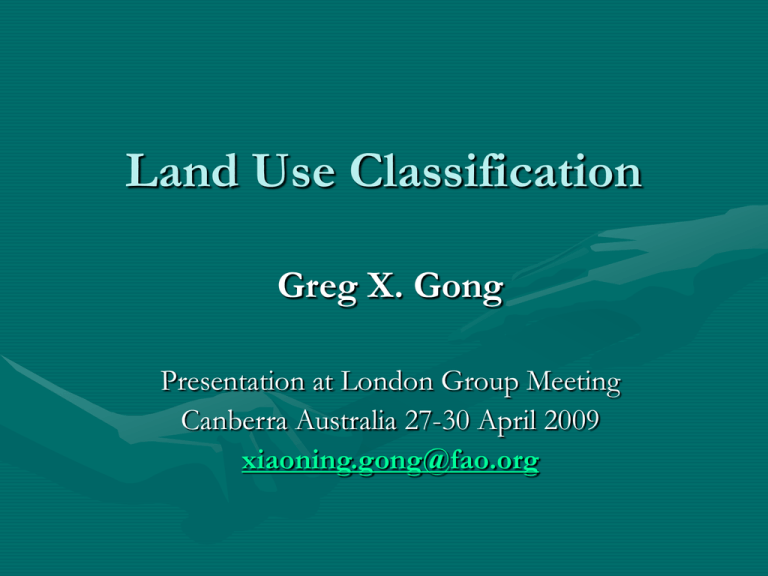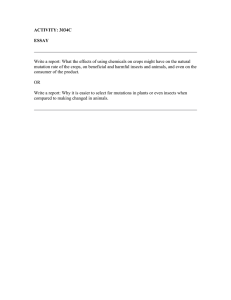Land Use Classification Greg X. Gong Presentation at London Group Meeting
advertisement

Land Use Classification Greg X. Gong Presentation at London Group Meeting Canberra Australia 27-30 April 2009 xiaoning.gong@fao.org Outline • Land cover vs. land use • Major global LU datasets • Structure and features of the proposed LU classification • Some discussions Land Cover vs. Land Use • LC is the observed (bio)-physical cover of the earth’s surface. Such an observation can be made by the human eye, aerial photographs, satellite sensors, or simply existing maps. • LU reflects the degree of human activities directly related to land and making use of its resources or having an impact (i.e. to produce products and benefits). LU requires field and ground information such as surveys and censuses. Major Global LU Datasets • Agricultural LU database in FAOSTAT since 1961. – “Land” under “Resources” – “Area Harvested” under “Production” • Decennial World Programme for the Census of Agriculture (WCA) since 1945. • Global Forest Resources Assessment Programme (FRA) since 1946. • “Global spatial database of sub-national agricultural land-use statistics” AGRO-MAPS Major Global LU Datasets (Cont’d) • FAO has collected number of units and areas of aquaculture facilities by – Type of grow-out structures: ponds and tanks, enclosures and pens, cages, raceways and silos, etc – Water types: freshwater, brackish water, and marine water and – Type of products: fishes, crustaceans, and molluscs • Classification used is based on the agreement at CWP, the coordinating mechanism established in 1959 to agree on standard concepts, definitions, classifications and methodologies for fishery statistics. Structure and features of the proposed LU classification • • • • Reflects the close relationship and integrative nature of the work on LU databases/datasets by various Departments and Divisions at FAO as discussed in the previous section. Provides a great flexibility in terms of application through its hierarchical structure. Establishes a linkage between itself with other major international classifications such as ISIC and CPC through the ICC. Integrates aquaculture and fishery land use including water bodies by applying consistent concept as agricultural and forest land use. Some Discussions • On one hand, it should adhere to the commonly agreed principles resulting from previous theoretical and empirical researches in this field; and on the other hand, it has to be rooted in the existing LU global statistical databases. • The function of such a LU classification just like many currently used at the global level is mainly to serve as a correlation system through which land use classes from existing national systems could be correlated and global LU databases can be continuously maintained and developed. Some Discussions (Cont’d) • Irrigation is not included in the proposed LU classification due to two difficulties: One is conceptual and the other is practical one. - Irrigation is one of many “land use attributes” used to describe one feature or property of land use on a plot. Other attributes relevant to agriculture, for example, are land tenure, cropping systems, use of fertilizers, mechanization, soil conservation practices, commercial or subsistence orientation (Young 1994). Any of them can be added into the LU classification just as irrigation. Apparently, however, it is not feasible for a classification to accommodate all these attributes - at the same time Other difficulties concern the data available of the related information. At present, there is no summary data for the world total area of agricultural land use with the breakdown of irrigation in FAOSTAT. Some Discussions (Cont’d) • Indicative Crop Classification (ICC) Proposed LU Classification 1 L1 L2 L3 L4 L5 L6 Proposed LU Classification Country area 2 3 4 5 6 7 Land area 100000 Agricultural area 110000 Arable land and Permanent crops 111000 Arable land 111100 111110 Land under temporary crops 8 111111 Cereals 9 111112 Vegetables and melons 10 111113 Temporary oilseed crops 11 111114 Root/tuber crops with high starch or inulin content LU Classification (Cont’d) 1 L1 L2 L3 L4 L5 111116 Leguminous crops 13 111117 Sugar crops 14 111119 Other temporary crops 15 111120 Land under temporary meadows and pastures 111121 Temporary grasses and other fodder crops 17 18 Proposed LU Classification 111115 Temporary spice crops 12 16 L6 111130 Land temporarily fallow LU Classification (Cont’d) 1 L1 L2 L3 19 L4 L5 111200 111210 111212 Permanent oilseed crops 21 111213 Beverage and permanent spice crops 22 111219 Other permanent crops 23 25 Land under permanent crops 111211 Fruit and nuts 20 24 Proposed LU Classification L6 112000 112100 112110 Permanent meadows and pastures 112111 Permanent grasses and other fodder crops LU Classification (Cont’d) 1 26 27 L1 L2 L3 L4 120000 L6 Proposed LU Classification Forest and other wooded land Forest 121000 28 Naturally regenerated forest 121100 29 30 121200 31 32 L5 122000 121110 Primary forest 121120 Other naturally regenerated forest Planted forest Other wooded land LU Classification (Cont’d) 1 33 L1 L2 L3 130000 131000 L4 L5 Proposed LU Classification L6 Land with aquaculture facilities 34 131110 Hatcheries 35 131120 Managed grow-out sites 131121 Fish 36 131122 Crustaceans 37 131123 Molluscs 38 131124 Others 39 40 140000 Other land LU Classification (Cont’d) 1 L1 41 200000 42 L2 L3 L4 L5 Inland water Areas with aquaculture or holding facilities 211000 211121 Fish 43 211122 Crustaceans 44 211123 Molluscs 45 211124 Others 46 47 48 49 Proposed LU Classification L6 Other inland water areas 212000 212100 Enhanced areas 212200 Open access waters without enhancement LU Classification (Cont’d) 1 L1 50 300000 L2 L3 L4 L5 Marine water Areas with aquaculture or holding facilities 311000 51 311121 Fish 52 311122 Crustaceans 53 311123 Molluscs 54 311124 Others 55 56 57 Proposed LU Classification L6 Other marine water 312000 312100 Enhanced areas 312200 Open access waters without enhancement Example: Data from an Academic Database Asia Africa N. and C. America S. America Europe Oceania Cropland 22% 6% 15% 8% 20% 4% Forest 21% 17% 51% 53% 61% 8% Savannah/Grassland 17% 36% 10% 26% 7% 36% Shrub land 16% 9% 10% 9% 1% 51% Other land 24% 33% 14% 5% 10% 0% million hectares 3,074 2,976 Major Land Use (1992) 2,149 1,761 2,246 842 Source: Center for Sustainability and the Global Environment http://www.sage.wisc.edu/ Summary and Conclusion • • • • LU classification is important. The Proposed LU classification is a joint effort of three Departments at in charge of three areas of statistics: Agriculture, fisheries, and forestry. It is based on the existing major LU databases and experience of FAO. The Proposed LU classification is a common classification for the above three fields at the global level.




